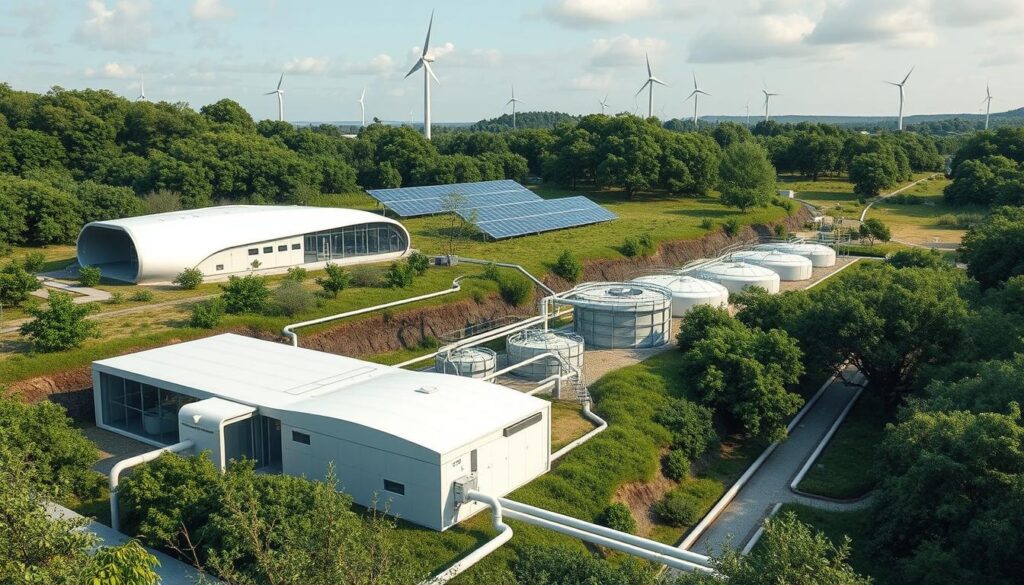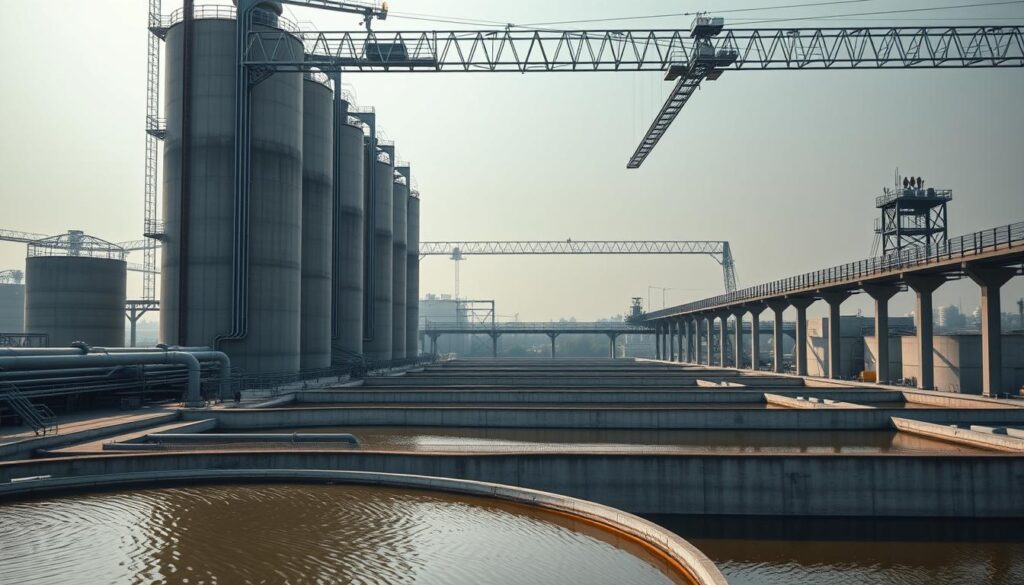The world is facing an unprecedented waste management crisis. Over 2 billion tons of waste are produced globally every year, and this number is expected to rise to 3.4 billion tons by 2050.
The growing waste management issue demands innovative approaches to waste disposal. Sanitation system engineering plays a crucial role in addressing this challenge, incorporating technologies like IoT-enabled waste bins and pneumatic waste pipes to mitigate the problem.
Efficient wastewater treatment and environmental sanitation design are critical components in the quest for sustainable waste management solutions.
Key Takeaways
- Innovative waste disposal methods are crucial for addressing the global waste crisis.
- Sanitation system engineering is vital for effective waste management.
- Technologies like IoT-enabled waste bins are being adopted worldwide.
- Efficient wastewater treatment is a key aspect of sustainable waste management.
- Environmental sanitation design plays a significant role in mitigating waste issues.
Understanding Sanitation System Engineering
With the increasing challenges of urbanization and environmental degradation, sanitation system engineering has become more crucial than ever. Sanitation system engineering is vital for maintaining public health and safety by ensuring effective waste disposal and management.
Definition and Importance
Sanitation system engineering refers to the application of engineering principles to design, construct, and maintain systems for the collection, treatment, and disposal of waste. This field is critical because it directly impacts public health by preventing the spread of diseases. Effective sanitary engineering projects are essential for providing clean environments and reducing health risks.
The importance of sanitation system engineering lies in its ability to provide water management systems that are integral to both urban and rural development. By ensuring that waste is managed properly, communities can avoid water contamination and related health issues.
Historical Context
Historically, sanitation system engineering has evolved significantly, from simple sewage systems in ancient civilizations to complex modern infrastructures. The development of sanitation engineering services has been driven by the need to address public health concerns and adapt to growing populations and urbanization.
Understanding the historical context of sanitation system engineering helps in appreciating the advancements made and the challenges that still need to be addressed. It highlights the importance of continued innovation in sanitary engineering projects to meet future demands.
Key Components of Sanitation Systems
Understanding the key components of sanitation systems is essential for designing effective waste management solutions. Sanitation systems are complex networks that require careful planning, execution, and maintenance to ensure they operate efficiently.
Waste Collection and Transport
Waste collection and transport are critical components of sanitation systems. Efficient waste collection is the first step in maintaining a clean and healthy environment. Modern technologies such as smart waste bins and pneumatic waste pipes are being increasingly used to improve waste collection and transport. These technologies help reduce waste accumulation, minimize odors, and decrease the need for manual handling.
For instance, smart waste bins are equipped with sensors that monitor waste levels, allowing for optimized collection routes and schedules. This not only reduces operational costs but also enhances the overall efficiency of the waste management system. To learn more about innovative sanitation systems, visit sanitation systems design.
| Technology | Description | Benefits |
|---|---|---|
| Smart Waste Bins | Equipped with sensors to monitor waste levels | Optimized collection routes, reduced costs |
| Pneumatic Waste Pipes | Transport waste through underground pipes | Reduced manual handling, minimized odors |
Treatment Processes
Treatment processes are a crucial aspect of sanitation systems, ensuring that wastewater is treated effectively before being discharged into the environment. Wastewater treatment involves various physical, chemical, and biological processes to remove contaminants. Advanced treatment technologies are being adopted to improve the efficiency and effectiveness of wastewater treatment.
Some of the key treatment processes include physical treatment methods such as sedimentation and filtration, chemical treatment methods like disinfection, and biological treatment methods that utilize microorganisms to break down organic matter. The choice of treatment process depends on the type and quantity of wastewater, as well as environmental regulations.

Effective sanitation systems are vital for urban sanitation solutions, ensuring that cities remain clean and hygienic. By incorporating innovative technologies and treatment processes, sanitation systems can be designed to meet the needs of growing urban populations while minimizing environmental impact.
Types of Sanitation Systems
Understanding the different types of sanitation systems is essential for implementing effective waste management solutions. Sanitation systems vary based on their design, functionality, and the context in which they are used.
Centralized vs. Decentralized Systems
Sanitation systems can be broadly categorized into centralized and decentralized systems. Centralized systems are characterized by a network of pipes that collect wastewater from households and businesses, transporting it to a central treatment facility. This approach is common in urban areas where infrastructure is well-developed.
Decentralized systems, on the other hand, treat wastewater at or near the source. This approach is particularly useful in rural or remote areas where connecting to a centralized network is not feasible. Companies like Mosan are pioneering decentralized sanitation solutions that transform waste into valuable resources such as fuel and fertilizers, showcasing the potential of sustainable sanitation technology.
| Characteristics | Centralized Systems | Decentralized Systems |
|---|---|---|
| Infrastructure | Extensive network of pipes | Localized treatment |
| Cost | High initial investment | Lower upfront costs |
| Scalability | Scalable for large populations | Flexible for small or dispersed populations |
On-site Systems: Septic Tanks and More
On-site sanitation systems, such as septic tanks, are another critical component of sanitation system engineering. These systems are used in areas not served by centralized sewerage networks. Septic tanks work by allowing wastewater to settle and separate into layers, with bacteria breaking down the organic matter.
For more detailed information on sanitation systems and their applications, you can refer to resources such as this academic publication, which provides insights into the latest developments in the field.
The choice between centralized, decentralized, and on-site systems depends on various factors, including environmental sanitation design considerations, local regulations, and community needs. By understanding the advantages and challenges of each type, communities can make informed decisions about their sanitation infrastructure.
Innovative Technologies in Waste Management
The advent of innovative technologies is transforming the landscape of waste management. These advancements are crucial in addressing the challenges posed by urbanization and the increasing volume of waste generated globally. Effective waste management is essential for maintaining public health and environmental sustainability.
Smart Waste Monitoring
Smart waste monitoring systems utilize sensors and IoT technology to optimize waste collection processes. These systems can detect the fill level of waste bins, monitor waste composition, and provide real-time data to waste management authorities. This information enables more efficient routing of waste collection vehicles, reducing operational costs and environmental impact.
The implementation of smart waste monitoring systems is particularly beneficial in urban areas where waste generation is high. By streamlining waste collection, cities can reduce traffic congestion and lower emissions from waste collection vehicles. Moreover, smart waste monitoring can help identify areas where waste reduction initiatives can be most effective.

Biological Treatment Methods
Biological treatment methods are gaining prominence as an effective means of managing organic waste. These methods involve the use of microorganisms to break down organic matter, producing biogas and compost. Biogas can be used as a renewable energy source, while compost can improve soil fertility.
The application of biological treatment methods is versatile, ranging from small-scale household systems to large industrial facilities. These methods are particularly useful in agricultural communities where organic waste is abundant. By harnessing the potential of biological treatment, communities can reduce their reliance on fossil fuels and create valuable by-products.
In conclusion, innovative technologies such as smart waste monitoring and biological treatment methods are pivotal in enhancing waste management practices. As these technologies continue to evolve, they are likely to play an increasingly important role in urban sanitation solutions and wastewater treatment, contributing to more sustainable sanitary engineering projects.
Environmental Impact of Sanitation Systems
Reducing the environmental footprint of sanitation systems is essential for a healthier planet. Sanitation system engineering has become increasingly important in minimizing the adverse effects of waste disposal on the environment.
Mitigating Pollution
Effective sanitation engineering services play a crucial role in reducing pollution. By implementing advanced water management systems, communities can significantly decrease environmental risks associated with waste.
A study published on the National Center for Biotechnology Information (NCBI) website highlights the importance of sustainable sanitation practices in reducing environmental pollution. According to the study, “improved sanitation facilities can significantly reduce the environmental impact of human waste” https://pmc.ncbi.nlm.nih.gov/articles/PMC9069703/.
Sustainable Practices
Sustainable practices in sanitation system engineering involve designing systems that are not only effective but also environmentally friendly. This includes adopting environmental sanitation design principles that minimize waste and promote recycling.
| Sustainable Practice | Environmental Benefit |
|---|---|
| Recycling wastewater | Conserves water resources |
| Using renewable energy sources | Reduces carbon footprint |
| Implementing waste-to-energy systems | Minimizes landfill waste |
By adopting these sustainable practices, communities can reduce the environmental impact of their sanitation systems, contributing to a cleaner and healthier environment.
Regulations and Standards
Understanding the regulatory framework is essential for the successful implementation of sanitation systems. Regulations and standards play a crucial role in ensuring that sanitation system engineering meets the required safety, health, and environmental standards.
Overview of U.S. Sanitation Regulations
The United States has a comprehensive framework governing sanitation systems, including regulations at the federal, state, and local levels. The Environmental Protection Agency (EPA) plays a key role in setting national standards for sanitation and wastewater treatment.
Some of the key regulations include the Clean Water Act, which regulates discharges into U.S. waters, and the Safe Drinking Water Act, which ensures the quality of drinking water. Compliance with these regulations is crucial for effective sewage system design and overall sanitation system engineering.
| Regulation | Description | Impact on Sanitation |
|---|---|---|
| Clean Water Act | Regulates discharges into U.S. waters | Ensures water quality and safety |
| Safe Drinking Water Act | Ensures the quality of drinking water | Protects public health |
| National Pollutant Discharge Elimination System (NPDES) | Permits for discharges into waters | Controls pollution from point sources |
Importance of Compliance
Compliance with sanitation regulations is not only legally required but also crucial for the success of urban sanitation solutions. Non-compliance can result in significant fines, legal action, and damage to a community’s health and environment.
Moreover, adherence to regulations ensures that sanitation systems are designed and operated to protect public health and the environment. This includes proper sewage system design and the implementation of effective wastewater treatment processes.

By understanding and complying with regulations and standards, communities can ensure that their sanitation systems are effective, sustainable, and protective of public health and the environment.
Community Involvement in Sanitation Projects
Community involvement is a crucial element in the success of sanitation projects worldwide. The active participation of local communities ensures that sanitation initiatives are tailored to their specific needs and are more likely to be adopted and maintained over time.
Engaging Local Stakeholders
Engaging local stakeholders is a critical step in the development of effective sanitation engineering services. This involves not only informing the community about the benefits of improved sanitation but also listening to their concerns and incorporating their feedback into the planning process.
For instance, Mosan, a sanitation service, has successfully engaged with local communities through awareness and education programs, demonstrating the value of stakeholder engagement.
Education and Outreach Programs
Education and outreach programs play a vital role in promoting sustainable sanitation technology and practices within communities. These programs help to raise awareness about the importance of proper sanitation and hygiene, encouraging behavioral change.
Effective outreach programs often involve collaboration with local leaders, schools, and community groups to disseminate information and promote the adoption of improved sanitation facilities and practices.
By fostering community involvement, sanitation projects can achieve greater impact and sustainability, ultimately contributing to improved public health and environmental protection.
Challenges in Sanitation System Engineering
Despite advancements, sanitation system engineering encounters significant obstacles, particularly in low- and middle-income countries. These challenges are multifaceted and impact the effectiveness of sanitation projects.
Funding and Resources
One of the primary challenges is the lack of sufficient funding and resources. Sanitation projects often require substantial investment in infrastructure, technology, and personnel. However, many regions struggle to secure the necessary funds, leading to delayed or abandoned projects. Innovative financing models and partnerships with international organizations can help alleviate some of these funding constraints.
For instance, exploring new funding avenues and public-private partnerships can provide the necessary resources to move sanitation projects forward.
Infrastructure Limitations
Infrastructure limitations pose another significant challenge. Aging or inadequate infrastructure can hinder the efficient collection, treatment, and disposal of wastewater. In many cases, existing infrastructure is not equipped to handle the demands of growing populations or is in dire need of upgrade and maintenance.
To address these limitations, it’s crucial to invest in modernizing infrastructure and adopting innovative technologies that can enhance the capacity and efficiency of sanitation systems. This includes implementing advanced wastewater treatment processes and smart monitoring systems to optimize performance.

By understanding and addressing these challenges, we can work towards developing more effective and sustainable sanitation systems. This involves not only securing adequate funding and resources but also overcoming infrastructure limitations through innovation and strategic planning.
Case Studies of Successful Sanitation Projects
Sanitation system engineering has seen significant advancements, with various successful projects showcasing urban and rural sanitation solutions. These projects not only improve public health but also contribute to environmental sustainability.
Urban Sanitation Innovations
Urban areas face unique sanitation challenges due to high population densities. Innovative solutions, such as smart waste monitoring systems and advanced biological treatment methods, have been implemented in cities worldwide. For instance, some cities have adopted smart bins equipped with sensors that monitor waste levels, optimizing collection routes and reducing operational costs.
Another example is the use of decentralized wastewater treatment systems, which can be more efficient and less energy-intensive than traditional centralized systems. These innovations are crucial for managing urban waste effectively and ensuring a healthier environment for city dwellers.
Rural Sanitation Solutions
Rural sanitation presents different challenges, often related to infrastructure limitations and resource constraints. Successful projects in rural areas have focused on simple, sustainable, and community-based solutions. For example, the implementation of community-led total sanitation (CLTS) programs has been effective in promoting behavioral change and improving sanitation facilities in rural communities.
Additionally, technologies such as constructed wetlands have been used for wastewater treatment in rural areas. These systems are not only effective but also environmentally friendly, providing habitats for wildlife while treating wastewater.
These case studies demonstrate that with the right combination of technology, community engagement, and sustainable practices, it is possible to achieve significant improvements in sanitation, whether in urban or rural settings.
Future of Sanitation System Engineering
Sanitation system engineering is on the cusp of a transformation driven by innovative technologies and climate change considerations. As the world grapples with the challenges of providing clean water and sanitation to a growing population, the need for sustainable and resilient sanitation systems has never been more pressing.

Emerging Trends and Predictions
The future of sanitation system engineering will be shaped by several emerging trends. These include the adoption of sustainable sanitation technology, such as decentralized wastewater treatment systems and water recycling technologies. Additionally, the increasing use of digital technologies, such as IoT sensors and data analytics, will enable real-time monitoring and optimization of sanitation systems.
- Increased adoption of decentralized sanitation systems
- Integration of renewable energy sources into sanitation infrastructure
- Advancements in waste-to-resource technologies
For more information on innovative sanitation solutions, you can visit the International Water Association’s website for the latest updates on next-generation sanitation systems.
Role of Climate Change Considerations
Climate change is expected to have a significant impact on sanitation systems, with rising temperatures and changing precipitation patterns posing new challenges. Sanitation system engineers will need to design systems that are resilient to these changes, incorporating climate change considerations into their designs. This may involve the use of flood-resistant construction materials and the implementation of adaptive management strategies.
Some key strategies for addressing the impact of climate change on sanitation systems include:
- Designing sanitation infrastructure to be more resilient to extreme weather events
- Incorporating climate change projections into sanitation planning
- Promoting water conservation and efficient use practices
Human Health and Hygiene
Sanitation system engineering plays a vital role in safeguarding public health by implementing effective waste management strategies. The link between sanitation and public health is well-established, with proper sanitation being crucial for preventing the spread of diseases.
Link Between Sanitation and Public Health
The importance of sanitation in maintaining public health cannot be overstated. Poor sanitation leads to the spread of diseases, which can have severe consequences on communities, particularly in areas with inadequate healthcare infrastructure.
Some of the key ways in which sanitation impacts public health include:
- The transmission of waterborne diseases due to contaminated water sources.
- The spread of vector-borne diseases in areas with poor waste management.
- The risk of outbreaks of infectious diseases in communities with inadequate sanitation facilities.
Preventing Disease Transmission
Preventing disease transmission through improved sanitation is a multifaceted approach that involves several strategies. Effective sanitation system engineering is at the heart of these efforts, ensuring that waste is managed in a way that minimizes health risks.
Key strategies for preventing disease transmission include:
- Implementing proper waste treatment and disposal methods.
- Promoting hygiene practices through education and community outreach.
- Investing in infrastructure for safe water supply and sanitation facilities.
By adopting these strategies, communities can significantly reduce the risk of disease transmission and protect public health. It’s a critical step towards creating healthier environments and improving the quality of life for individuals around the world.
Integrating Sanitation with Urban Planning
The integration of sanitation systems with urban planning is a critical aspect of sustainable development. As cities expand and populations grow, the need for effective sanitation system engineering becomes increasingly important to maintain public health and environmental sustainability.

Importance of Coordination
Coordination between different stakeholders is essential for successful integration of sanitation with urban planning. This involves collaboration between urban planners, sanitation engineers, policymakers, and local communities to ensure that sanitation infrastructure is aligned with urban development goals.
Key aspects of coordination include:
- Aligning sanitation infrastructure with urban planning projects
- Ensuring compliance with regulations and standards
- Engaging local stakeholders in the planning process
Designing for Resilience and Adaptability
Designing sanitation systems that are resilient and adaptable is crucial for addressing the challenges posed by climate change, population growth, and urbanization. This involves incorporating flexible design principles and advanced technologies to create robust water management systems.
Strategies for designing resilient sanitation systems include:
- Implementing smart waste monitoring systems to optimize waste collection and treatment
- Using sustainable materials and practices in sanitation infrastructure
- Incorporating green infrastructure to manage stormwater runoff and reduce pollution
By integrating sanitation with urban planning and focusing on resilience and adaptability, cities can create more sustainable and livable environments for their residents.
Scaling Solutions Globally
As the world grapples with sanitation challenges, scaling effective solutions globally has become a pressing necessity. The importance of global sanitation cannot be overstated, as it directly impacts public health and environmental sustainability.
Developing countries have been at the forefront of innovating sanitation solutions, often driven by necessity. For instance, the implementation of innovative sanitation technologies like Mosan in Guatemala has shown promising results. Such initiatives not only improve local sanitation infrastructure but also provide valuable lessons for global application.
Lessons from Developing Countries
Developing countries have pioneered various sanitation solutions that can be scaled globally. One key lesson is the importance of adaptability and community involvement. For example, community-led total sanitation (CLTS) initiatives have been successful in numerous countries, promoting behavioral change and sanitation infrastructure development at the local level.
“Sanitation is a critical aspect of public health, and its improvement requires a multi-faceted approach that includes technology, community engagement, and policy support.” – A sanitation expert.
The success of such programs highlights the need for collaboration among governments, NGOs, and local communities. By working together, it’s possible to tailor sanitation solutions to the specific needs of different regions, enhancing their effectiveness and sustainability.
Collaboration Among Nations
International collaboration is essential for scaling sanitation solutions globally. It facilitates the sharing of knowledge, technologies, and best practices across borders. Organizations like the World Health Organization (WHO) and UNICEF play a crucial role in promoting global sanitation by supporting countries in their efforts to improve sanitation infrastructure and services.
| Initiative | Location | Impact |
|---|---|---|
| Mosan | Guatemala | Improved local sanitation infrastructure |
| CLTS | Multiple Countries | Promoted behavioral change and sanitation development |
Furthermore, global initiatives like the Sustainable Development Goals (SDGs) provide a framework for countries to work towards improving sanitation as part of broader development goals. The sanitation system engineering field is critical in this context, as it encompasses the technological and engineering aspects of sanitation, from waste collection to treatment and reuse.
In conclusion, scaling sanitation solutions globally requires a multifaceted approach that includes learning from developing countries and fostering international collaboration. By working together and leveraging the expertise and resources available, it’s possible to make significant strides in improving global sanitation.
Conclusion: The Path Forward in Sanitation Engineering
The future of sanitation system engineering relies heavily on continued innovation and stakeholder engagement. As discussed, innovations in waste management, such as smart waste monitoring and biological treatment methods, are transforming the field.
Innovations Recap
Sanitation system engineering has seen significant advancements, from decentralized systems to on-site septic tanks. These innovations have improved waste disposal efficiency and reduced environmental impact.
Engaging Stakeholders
Effective sanitation system engineering requires the active participation of stakeholders, including policymakers, engineers, and local communities. By working together, we can develop sustainable sanitation solutions that meet the needs of diverse populations.
As the world grapples with the challenges of urbanization and climate change, the importance of sanitation system engineering will only continue to grow. It is essential that stakeholders remain committed to promoting and investing in this critical field.
